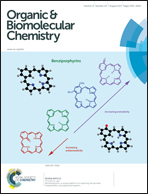Probing heterobivalent binding to the endocytic AP-2 adaptor complex by DNA-based spatial screening†
Abstract
The double helical DNA scaffold offers a unique set of properties, which are particularly useful for studies of multivalency in biomolecular interactions: (i) multivalent ligand displays can be formed upon nucleic acid hybridization in a self-assembly process, which facilitates spatial screening (ii) valency and spatial arrangement of the ligand display can be precisely controlled and (iii) the flexibility of the ligand display can be adjusted by integrating nick sites and unpaired template regions. Herein we describe the use of DNA-based spatial screening for the characterization of the adaptor complex 2 (AP-2), a central interaction hub within the endocytic protein network in clathrin-mediated endocytosis. AP-2 is comprised of a core domain and two, so-called appendage domains, the α- and the β2-ear, which associate with cytoplasmatic proteins required for the formation or maturation of clathrin/AP-2 coated pits. Each appendage domain has two binding grooves which recognize distinct peptide motives with micromolar affinity. This provides opportunities for enhanced interactions with protein molecules that contain two (or more) different peptide motives. To determine whether a particular, spatial arrangement of binding motifs is required for high affinity binding we probed the distance-affinity relationships by means of DNA-programmed spatial screening with self-assembled peptide-DNA complexes. By using trimolecular and tetramolecular assemblies two different peptides were positioned in 2–22 nucleotide distance. The binding data obtained with both recombinant protein in well-defined buffer systems and native AP-2 in brain extract suggests that the two binding sites of the AP-2 α-appendage can cooperate to provide up to 40-fold enhancement of affinity compared to the monovalent interaction. The distance between the two recognized peptide motives was less important provided that the DNA duplex segments were connected by flexible, single strand segments. By contrast, the experiments with a more rigid, duplex-spaced assembly revealed marked distance dependencies. Consequences for the function of adaptor proteins are discussed.


 Please wait while we load your content...
Please wait while we load your content...